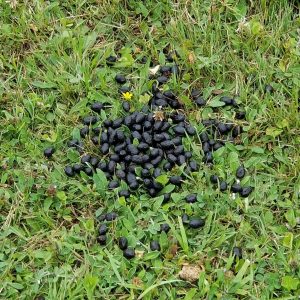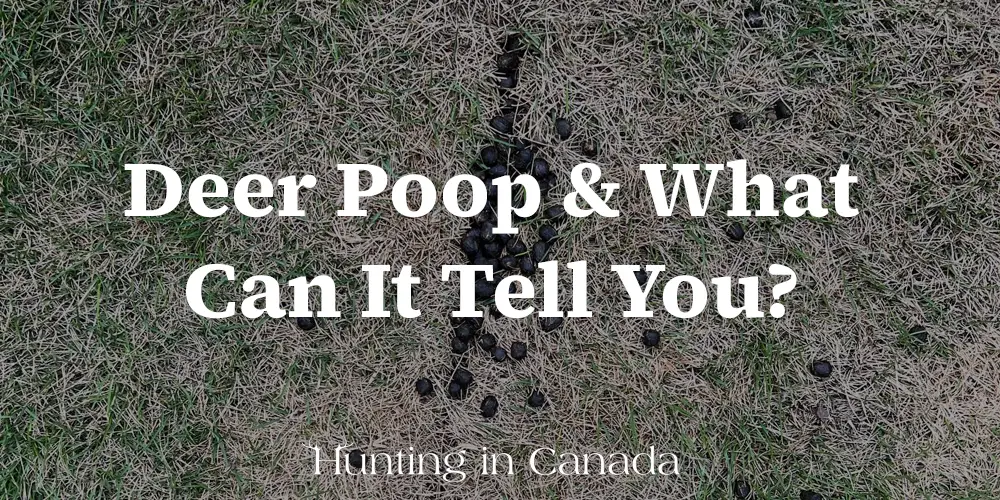Deer droppings, Why should you want to know about it? Well, there are many reasons. Deer hunters are obsessed with anything about deer, even deer poop, and they are likely to know one of these reasons already. If you can recognize the deer poop well, it will tell you a lot about your prey and help you to find it.
And if you live close to the forest, then the deer can be a serious problem. They will devour any plant they see and leave a mess for you to clean up. So if an animal is invading your garden or property and you suspect it is a deer, you can check their poop to confirm if it is a deer or not.
So what does deer poop look like, and what can it tell you about the deer? In this article, we will cover everything you would want to know about deer poop.
Deer Poop A lot

It’s no secret that deer produce a lot of scat. The number of deer defecations during the fall and winter months can amount to nearly 10-15 times per day, according to biologists.
When considering that deer travel together, this will mean a lot of various excretions throughout one whole day’s time.
Spring and summer are even more impressive as the deer will defecate between 20 and 30 times daily. Patterns of deer defecation are so predictable that some wildlife agencies can even make quite accurate guesses at deer populations based on the number of poop piles they discover within a specific area.
There is no doubt that hunters place their focus on rubs and scrapes in order to find deer hotspots. This might be a bad idea? Not at all. But If you come across a trail with lots of pellets on the ground, then it is something worth taking notice of.
What Does Deer Scat Look Like?
Deer feces are similar to those of other animals such as goats and rabbits. The difference lies in their size; deer pellets can be four times bigger than rabbit droppings, but it can be difficult at first glance to distinguish them from one another.
Texture
Deer are ruminants, which means that their food is thoroughly digested before leaving the body. Due to the deer diet, they have a lot of bowel motions each day, but these feces look smooth and shiny.
If the deer poop still looks shiny, moist, and dark in colour, then they are most probably younger than 12 hours old. But if the droppings look dry and lighter in colour, then they are probably at least 24 hours old. It might even be many days old at this point.
Size
The deer defecate larger piles that contain more pellets per bowel movement. A deer pellet can be in the range from 0.78 in (2 cm) to1.2 in (3 cm). Deer scat is much smaller than you would expect from an animal of its size.
Shape
Deer pellets are quite distinctive in shape. They typically have a shape that is similar to a bullet or pellet-like form. This is probably the most helpful in examining a deer scat to identify whether or not the deer has been in this area before. These pellets are oval-shaped, with one side having a tiny point due to the deer’s anal sphincter closing on the pellet.
Colour
Almost all deer scat is dark brown, sometimes even black. The animal poop colour is the final piece to know whether a deer is ruining your yard or another animal. If it’s not a dark brown or black colour, then they most likely are not coming from a deer.
Fawns Do Not Poop Where They Sleep
A baby deer only feels the urge to poop when its mother stimulates them, which occurs during nursing. Mother deer will go to an area that is far away from their hiding places and bedding areas to nurse their fawns and to let them empty their bowels.
Mother doe will frequently eat the droppings of their fawns in order to reduce the risk of being tracked by predators and keep them safe.
The predators can detect the scent of the mother deer; therefore, the doe leaves her fawn in a safe place until it’s time for nursing again. This way, no predator will be able to track down the mother and find the helpless fawn.
Buck Scat Piles Are Larger
Bucks often leave more pellets in a pile when compared with the does. On average, the buck pile can include a range from 70 to 80 pellets. In contrast, there are usually between 50 and 60 pellets on the doe pile. For hunters, the size of the drooping pile can give some clues about the size of the deer in the area.
Deer Droppings Can Tell If You Are In A Feeding Or A Bedding Area
Deer droppings can be a great way to identify both feeding areas and bedding areas for deer. They often poop close to their bedding area, and the poop pile will usually be clumped or uniform.
If you are hunting in a wooded area and you find a large number of deer poo in any location, it could be an indication that they are using this area for bedding. So in order to know where the exact bedding area is, look for a spot that resembles a deer bed. If you notice that the piles are still fresh, it’s likely that this bedding area has been recently used by the deer.
The deer also poop while eating, so you can also use it to find the deer feeding area. When you find a lot of deer poop piles in an open field or meadow, then you have found the deer food source. Those deer dropping piles may be more spread out
What Can You Learn About A Deer From Its Droppings?
Deer droppings contain clues to what the animal has been eating. You can take a close look to know more about the diet of deer. The deer scat composition and shape will differ if the deer get a lot of water in its forage.
Firm deer pellet piles mean that the diet of the deer is probably made up of a hard mast (such as nuts and acorns), woody browse (like twigs, leaves, and buds), and grain (such as oats, soybeans, and corn).
If the poop is not in piles, but instead it is in singles, or it appears to be softer and probably has a long shape, then the deer diet probably involves soft mast ( plums, peaches, pears, persimmons, and other fruits), forbs, and/or broadleaf plants.
Generally, the larger the piles are, the larger the deer is likely to be. A large pile probably comes from a deer with a weight range from 150 to 250 pounds. While small pellet piles usually come from fawns and does with a weight range of 75 and 125 pounds
If you find an area where there is a lot of deer poop, this is probably because the deer frequent the same place. It is a great place to hang your tree stand and start hunting.
You can concentrate on large piles before or after the rut. But during the rut, your best tactical plan is to set up your stand close to the doe droppings. Mature bucks will be looking for the does to find potential mates.
Shiny, wet-looking deer droppings have a high content of moisture; It was probably made within the last 6-12 hours. You can hunt in this area immediately or within the next day.
If you found a dried-out, dull pellet pile, this means that it is a day old or more. It will be even older if the pellets are shrunken, hard and lightening in colour. This deer is likely no longer using this area. You should look for another spot.
Can You Tell By The Deer Dropping Shape Whether It Is A Buck Or A Doe?
The commonly held belief is that the buck pellet and doe pellet differ in shape; the bucks produce larger tubular excrements, while the doe makes small, pelleted piles. But Science would disagree.
According to biologists, both the buck pellets and doe pellets’ shape is the same. So it is virtually impossible for hunters to distinguish between both sexes’ poop. So you can not indicate whether it is a buck or a doe with the poop shape alone.
Is Deer Scat Hazardous?
The deer’s droppings can carry dangerous diseases, so be careful when you examine them. For instance, if a deer has a chronic wasting disease (CWD), then its poops will have disease prions in them. While it is still uncertain if humans can contract the disease, there is a possibility. So, it is not advisable for humans to touch wild animal feces directly.

